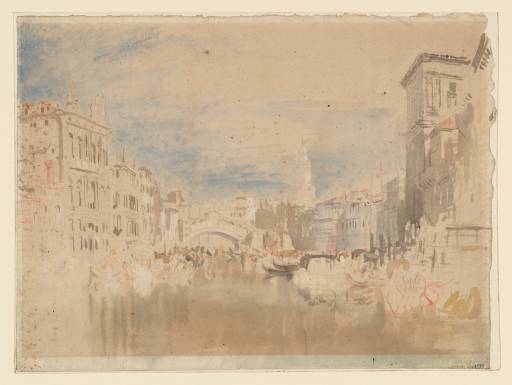Joseph Mallord William Turner The Grand Canal, Venice, near the Palazzi Grimani and Papadopoli, with the Rialto Bridge Beyond 1840
Joseph Mallord William Turner,
The Grand Canal, Venice, near the Palazzi Grimani and Papadopoli, with the Rialto Bridge Beyond
1840
Joseph Mallord William Turner 1775–1851
The Grand Canal, Venice, near the Palazzi Grimani and Papadopoli, with the Rialto Bridge Beyond 1840
D32211
Turner Bequest CCCXVII 26
Turner Bequest CCCXVII 26
Chalk, pencil and watercolour on pale buff wove paper, 228 x 307 mm
Blind-stamped with Turner Bequest monogram towards bottom right
Inscribed by John Ruskin in blue ink ‘1590’ bottom right
Stamped in black ‘CCCXVII – 26’ bottom right
Blind-stamped with Turner Bequest monogram towards bottom right
Inscribed by John Ruskin in blue ink ‘1590’ bottom right
Stamped in black ‘CCCXVII – 26’ bottom right
Accepted by the nation as part of the Turner Bequest 1856
Exhibition history
1904
National Gallery, London, various dates to at least 1904 (353, as ‘Venice: The Rialto’).
1937
Watercolours from the Turner Bequest, Gloucester, May–July 1937 (no catalogue, but frame no.6).
References
1904
E.T. Cook and Alexander Wedderburn eds., Library Edition: The Works of John Ruskin: Volume XIII: Turner: The Harbours of England; Catalogues and Notes, London 1904, pp.384, 625 no.353, as ‘Venice: The Rialto’.
1909
A.J. Finberg, A Complete Inventory of the Drawings of the Turner Bequest, London 1909, vol.II, p.1025, CCCXVII 26, as ‘The Rialto. Exhibited Drawings, No.353’.
1930
A.J. Finberg, In Venice with Turner, London 1930, p.175, as ‘The Grimani palace with the Rialto ... may be connected with the “Shylock” (R.A.1837)’, 1835.
2003
Ian Warrell in Warrell, David Laven, Jan Morris and others, Turner and Venice, exhibition catalogue, Tate Britain, London 2003, pp.151, 259, 264 note 11.
Finberg later annotated his basic 1909 Inventory entry (‘The Rialto’): ‘with P. Grimani, &c. on r. ? study for Mr Brocklebank’s “Shylock.”’ (as discussed below).1 Turner’s viewpoint was about level with the Calle Traghetto Vecchio on the south side of the Grand Canal, looking north-east to the Rialto Bridge and the Fondaco dei Tedeschi at the bend beyond. On the left is the Palazzo Papadopoli, with its twin obelisk finials, with the lower Palazzo Giustiniani Businello to its right.
Above the roofs south of the bridge is the campanile of San Bartolomeo. The tallest of the buildings shown complete on that side is the Palazzo Grimani di San Luca, now Venice’s Appeal Court. Coming forwards below it are the Palazzi Corner Contarini dei Cavalli, Tron and D’Anna Viaro Martinengo Volpi di Misurata, with details of the latter two fading out towards the right-hand edge. The scene is much the same as in a more finished watercolour and gouache view on grey paper (Tate D32212; Turner Bequest CCCXVII 27), likely also from 1840;2 there the focus shifts to the right, with the right foreground in more detail and the Palazzo Papadopoli excluded from the left. The handling in the present variation appears more immediate, suggesting rapid observation of the fall of light and shadow (compare Tate D32149 and D32169; Turner Bequest CCCXVI 12, 32, also in this subsection).
The view evoked various associations for Turner, and is effectively the same that in a detailed pencil study in the 1819 Milan to Venice sketchbook (Tate D14455–D14456; Turner Bequest CLXXV 73, 74). That prospect had been used for a watercolour, The Rialto, Venice (Indianapolis Museum of Art),3 made in 1820 or 1821 for Turner’s friend and patron Walter Fawkes. Its composition echoed that of a watercolour (currently untraced),4 engraved in 1820 for James Hakewill’s Picturesque Tour of Italy (Tate impression: T06012) as The Rialto, Venice, based on Hakewill’s own sketch. These works had also informed the upright-format oil painting The Grand Canal, Venice, exhibited at the Royal Academy in 1837 (Huntington Library, Art Collections, and Botanical Gardens, San Marino, California).5 As noted above, Finberg had tentatively linked the present sheet to the painting (featuring Shylock, from Shakespeare’s Merchant of Venice), although it is now accepted as post-dating the oil, so any intentional similarity would have been retrospective.6
Without further elaboration, in 1881 John Ruskin categorised this work among twenty-five Turner Bequest subjects ‘chiefly in Venice. Late time, extravagant, and showing some of the painter’s worst and final faults; but also, some of his peculiar gifts in a supreme degree.’7
Undated MS note by Finberg (died 1939) in interleaved copy of Finberg 1909, Prints and Drawings Room, Tate Britain, II, opposite p.1025; see also Finberg 1930, p.175.
Technical notes:
Details at the right-hand side are worked right up to the somewhat irregular edge. Owing to prolonged early display, the sheet is considerably darkened except where the edges were protected by a mount.
This is one of a few 1840 Venice works Ian Warrell has noted as on ‘Pale buff wove paper, produced by an unknown maker, with the watermark: “J W”’:1 Tate D32148–D32149, D32169, D32211, D32219, D32247 (Turner Bequest CCCXVI 11, 12, 32, CCCXVII 26, 34, CCCXVIII 28); see also Venice from the Lagoon (Fitzwilliam Museum, Cambridge),2 and The Rialto, Venice and The Palazzo Balbi on the Grand Canal, Venice (National Gallery of Scotland, Edinburgh).3 Warrell has noted paper conservator Peter Bower’s suggestion ‘that this type of paper was a deliberate forgery of Whatman paper and was possibly produced in Austria’,4 and that the ‘inferior quality has resulted in visible changes to the paper, which is especially prone to fading’.5
How to cite
Matthew Imms, ‘The Grand Canal, Venice, near the Palazzi Grimani and Papadopoli, with the Rialto Bridge Beyond 1840 by Joseph Mallord William Turner’, catalogue entry, September 2018, in David Blayney Brown (ed.), J.M.W. Turner: Sketchbooks, Drawings and Watercolours, Tate Research Publication, December 2019, https://www

